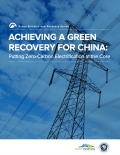This report assesses two recovery plans that could boost both GDP and protect jobs. The first plan follows a ‘return to normal’ approach by reducing VAT rates and encouraging households to resume spending. The second plan is a ‘Green’ Recovery Plan that aims to boost economic activity while simultaneously reducing CO2 emissions.
This report provides an analysis of the environmental and socio-economic hotspots along the entire textile value chain and looks at a range of associated impacts, as well as at how different stages in the value chain are dominant in different impacts.
The Kigali Cooling Efficiency Program (K-CEP), a philanthropic collaboration active in over 50 countries, has identified six high-impact opportunities that can reduce emissions, increase job creation, and enhance economic output through the inclusion of efficient, climate-friendly cooling in stimulus packages.
Stimulus efforts to recover from impacts of the COVID-19 pandemic should aim to accelerate progress in implementing distributed energy resources (DER) solutions and provide other significant benefits.

The COVID-19 crisis has had a massive impact on economies across the world, with several governments now seeking to design recovery programs. Ideally such programs should not only support recovery from recession but help achieve greener and more sustainable economies for the future. This report recommends that China’s green recovery package combine four key actions.
